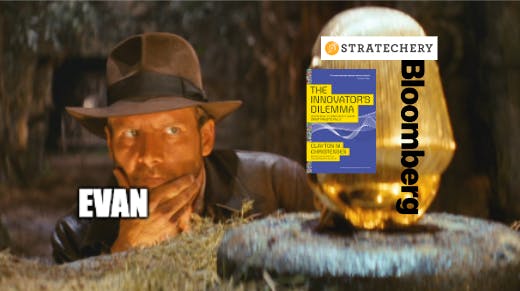Subscribe
Sign in
Why culture eats strategy

Share On
The search for the winning formula
Evan Armstrong is an investor, founder, and adviser. He's a lead writer at Every, where he writes the Napkin Math, a publication focused on business breakdowns, by the numbers. Find him on Twitter: @itsurboyevan.
All entrepreneurs want to know how to win. Investors all want to know how to pick winners. The issue is that no one can really agree how to do either.
Depending on who you talk to, you’ll hear different gospels espoused. Some are devotees of the cult of the founder. For such an adherent, there are entire publications all devoted to the study of successful people.
Simultaneously, there are those who prefer the magic of ⭐frameworks⭐. Their divine prophets are thinkers like Clayton Christensen and Michael Porter. This kind of thinking makes sense to me! Surely there is a “right way” to build a billion dollar company.
For many years, I felt like I was just on the cusp of understanding the secret. I was an archaeologist, digging through hundreds of books—company profiles, strategy theory, biographies of founders—to find the buried treasure of truth. I religiously read all the newsletters people told me to subscribe to, listened to the podcasts by all the greats, and tried to understand the “why” behind the headlines. I was driven by this deep hunger to understand.

Now, ~10 years into this journey, I have started to form a new thesis that runs somewhat contrary to existing methods of evaluation.
I would propose that the secret to building a successful technology company is culture-market fit. Culture-market fit (CMF) is that blissful intersection of an opportunity in the market with a culture that can execute on said opportunity. Allow me to clarify: CMF occurs when an organization matches with an opportunity, and the organization’s culture allows the right strategies and process to occur allowing them to capture said opportunity. Sometimes that will mean giving employees lots of freedom (Google), and sometimes that will mean micro-managing people (Amazon), but the important thing is that the culture cultivated correctly addresses the market opportunity. A company’s culture is a vibe, an ethos, that permeates every slide deck, every product decision, every analysis. When there is no clear right answer (which is always) the culture-market fit is what drives decisions.
Culture-market fit does not mean that the organization is hyper-aligned with customer interests, either. CMF is determined by crafting the internal culture that wins the external market. Sometimes that is aligned with customers, but sometimes it is also done through more…company-oriented decisions. Exxon and Chevron and nearly every Big Bank regularly screw over their customers but are still fiscally successful over an extended period. Some companies are motivated by ethos, some by greed, some by hubris, but all winners match their culture and incentives to the market they are serving. A market opportunity is where a business can extract the most long-term profits, not necessarily the one that gives customers the goods or services they would most prefer. Empowered founders are important and so are strategy planning sessions, but they are all cultural outputs.
If I am correct, then this framing has important implications for capital deployment inside of organizations and in which startups are best for funding. I want to emphasize something: I recognize how pie-in-the-sky, non-numeric this idea is. It is not as intellectually soothing as a perfectly crafted chart or spreadsheet. However, I’m increasingly convinced that businesses are made in the ugly, daily, poorly illuminated decisions. In those times, it isn’t spreadsheets that wins—it’s culture-market fit.
TL;DR
- Culture-market fit is more important than product-market fit because it precludes any product decision
- Culture is the deep understanding of your customers, the people you hire to serve those customers, and the approach those individuals use to serve customers
- Having CMF means that your organization’s design, product, and operating mandate match the market opportunity.
Comments (9)
Lisa Oreshkina@lisa_oreshkina

The Breakfast
Feels very true, thank you for the piece!
Share

ParagraphAI - Write better, faster
Culture eats strategy for breakfast. This famous quote, often attributed to Peter Drucker, highlights the importance of culture in the success of an organization. Culture is the set of values, beliefs, and behaviors that define how an organization functions. It shapes the decisions that employees make, the way they interact with customers, and the overall atmosphere of the workplace. A strong culture can be a major competitive advantage, while a weak culture can lead to dysfunction and failure.
Strategy is important, but it is only part of the equation. Culture is what determines whether a strategy will be executed effectively or not. If the culture of an organization is not aligned with its strategy, the strategy is likely to fail. This is why culture is so important: it can make or break a strategy.
Written with ParagraphAI. - We're trending, just launched on PH Homepage today!
@papa's pizzeria It's so great.
Amazing piece Evan!
Culture and values are the lens through which any employee looks at a situation before making a decision. Nobody understands the product and the market as well as the founders do(usually) , a good culture is what compensates this lack of understanding.

Convertfiles.ai
Well versed
Fantastic insight
More stories

Mathew Hardy · How To · 3 min read
How to Detect AI Content with Keystroke Tracking

Sanjana Friedman · Opinions · 9 min read
The Case for Supabase

Vaibhav Gupta · Opinions · 10 min read
3.5 Years, 12 Hard Pivots, Still Not Dead
Kyle Corbitt · How To · 5 min read
A Founder’s Guide to AI Fine-Tuning

Chris Bakke · How To · 6 min read
A Better Way to Get Your First 10 B2B Customers
